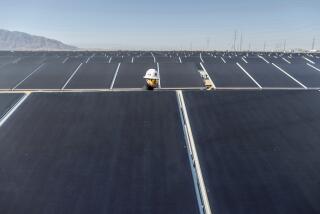Editorial: Last-minute maneuvering by utilities could throw a shadow over California’s solar revolution
Here’s a simple guideline for the California Public Utilities Commission when it votes next week on a new rate scheme for rooftop solar users who also connect to the electric grid: Don’t be like Nevada.
Last month, public utility commissioners in that super-sunny state put the chill on the burgeoning rooftop solar market by imposing steep monthly fees on solar customers while slashing the compensation they are paid for the excess power they return to the grid. In so doing, Nevada made it virtually unaffordable for the typical homeowner to install solar panels. Good going, guys.
Commissioners in California, by comparison, have crafted a reasonable proposal that makes solar users pay to draw power from the grid when the sun doesn’t shine, while maintaining a healthy credit for the power they contribute during the day. The PUC is set to take a final vote on this proposal next week, but the state’s three big electric utilities — Southern California Edison, San Diego Gas & Electric and Pacific Gas & Electric — are agitating for last-minute changes to squeeze more money out of solar users.
Join the conversation on Facebook >>
These customers can afford it, the utilities argue, now that a key federal tax credit for solar power has been renewed. Congress surprised the solar industry in December by extending a 30% credit for the installation of solar-power equipment that was set to expire this year. Besides, the utilities claim, the current proposal is not fair because it would make all ratepayers subsidize the rich people who can afford to go solar. This argument might have seemed reasonable in, say, 1995, when solar panels really were out of most people’s reach. Not so today, when the tax credit and new business models are making solar setups affordable to homeowners of all income levels. As the market grows, it should become even more affordable.
Nor is it clear how much, if any, subsidy the proposed rates would provide to solar users, given the changing price of panels and innovation in business models. What we do know is that every kilowatt generated by rooftop solar panels in Sylmar or Stockton means one kilowatt that didn’t come from nonrenewable sources. Furthermore, the solar industry makes the case that extra power generated by a home with rooftop solar and sold to neighbors reduces the cost of transmitting power into that community. In any case, there is always a cost to worthwhile investments. And keeping solar affordable will pay off for all Californians, whether they decide to switch or not, by reducing greenhouse gases and, potentially, the need for new power plants. Interestingly, Southern California Edison cited that same sort of shared benefit last week when it touted its $355-million plan to build 30,000 electric charging stations paid for by ratepayers — all of them, not just those who own electric vehicles.
Transitioning to renewable energy requires regulators to strike a delicate balance, providing incentives that drive investment without placing undue burden on everyone else. Nevada didn’t find the right balance. In its current proposal, the CPUC did.
MORE
Smug about your solar roof? Not so fast.
Utilities push a solar pricing proposal they say is fairer for non-solar users
More to Read
A cure for the common opinion
Get thought-provoking perspectives with our weekly newsletter.
You may occasionally receive promotional content from the Los Angeles Times.






